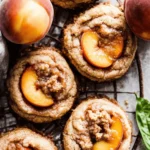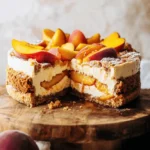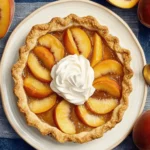This soft banana bread is a moist and tender treat made effortlessly in a bread machine. Using ripe bananas, this recipe yields a flavorful, perfectly textured loaf ideal for breakfast or a snack.
FULL RECIPE
Ingredients
- 3 ripe bananas, mashed
- 1/3 cup melted butter
- 3/4 cup brown sugar
- 1 large egg
- 1 teaspoon vanilla extract
- 1 1/2 cups all-purpose flour
- 1 teaspoon baking soda
- 1/2 teaspoon salt
- 1/2 teaspoon ground cinnamon (optional)
Directions
- Add mashed bananas, melted butter, brown sugar, egg, and vanilla extract to the bread machine pan.
- In a separate bowl, whisk together flour, baking soda, salt, and cinnamon.
- Add the dry ingredients to the bread machine pan on top of the wet ingredients.
- Select the “Quick Bread” or similar setting on your bread machine and start the cycle.
- Once the cycle finishes, remove the banana bread and let it cool on a wire rack before slicing.
Nutritional Information
- Calories: 180
- Total Fat: 6g
- Saturated Fat: 3.5g
- Cholesterol: 35mg
- Sodium: 220mg
- Total Carbohydrates: 30g
- Dietary Fiber: 1g
- Sugars: 15g
- Protein: 2g
The History and Origins of Banana Bread
Banana bread originated in the United States during the Great Depression, a time when resourcefulness in the kitchen was essential. It became popular as a way to use overripe bananas that would otherwise be discarded, turning them into a delicious and satisfying baked good. Over the decades, banana bread has evolved from a simple homemade treat to a staple recipe with many variations, including the convenient bread machine version that simplifies the baking process.
Why Use Ripe Bananas?
Ripe bananas are crucial for the best flavor and texture in banana bread. As bananas ripen, their starch converts to sugar, making them sweeter and softer. This natural sweetness reduces the need for added sugar, while the soft texture contributes to the moistness of the bread. Overripe bananas with brown spots are ideal because they have the most sugar content and a strong banana flavor.
The Role of the Bread Machine
Using a bread machine to make banana bread offers convenience and consistency. Bread machines handle the mixing, kneading, and baking all in one appliance, which simplifies the process, especially for beginners or busy bakers. The controlled environment ensures even baking and reduces the risk of overmixing, which can make bread tough.
Moisture and Texture in Banana Bread
One of the hallmarks of great banana bread is its moist texture. The combination of mashed bananas and melted butter contributes to this moisture. The bananas add natural liquid while the butter adds richness and tenderness. Proper balance between wet and dry ingredients is essential to avoid a dry or dense loaf.
The Importance of Leavening Agents
Baking soda is the most commonly used leavening agent in banana bread because it reacts with the acidic compounds in bananas and brown sugar to produce carbon dioxide gas. This reaction helps the bread rise and become light and fluffy. Using too much or too little baking soda can affect the texture and flavor, so precise measurement is important.
Adding Cinnamon for Flavor Depth
Cinnamon is often added to banana bread recipes to enhance the flavor profile. Its warm, spicy notes complement the sweetness of bananas and brown sugar without overpowering them. This subtle spice adds complexity and makes the bread feel more aromatic and inviting.
Substitutions and Variations
Banana bread is highly adaptable. Some people substitute part of the all-purpose flour with whole wheat or oat flour for a nuttier flavor and added fiber. Others add nuts like walnuts or pecans for crunch, or mix in chocolate chips for extra sweetness. Vegan versions swap eggs and butter for plant-based alternatives, while gluten-free options use suitable flours.
Health Considerations
While banana bread can be a tasty treat, it often contains sugar and fat, which contribute to its calorie content. However, using ripe bananas reduces the need for added sugars. Including whole grain flours and nuts can increase the nutritional value by adding fiber, protein, and healthy fats. Moderation is key when enjoying this bread as part of a balanced diet.
Storing Banana Bread
Banana bread stores well at room temperature, ideally wrapped in plastic wrap or kept in an airtight container to maintain moisture. It can also be refrigerated to extend freshness, though refrigeration may slightly dry the bread. For longer storage, freezing slices wrapped in foil or plastic wrap preserves flavor and texture for several months.
Serving Suggestions
Banana bread is versatile in serving. It can be eaten plain or toasted with butter or cream cheese. Some enjoy it as a breakfast item paired with coffee or tea, while others serve it as a dessert with a drizzle of honey or a scoop of ice cream. It also works well as a snack for any time of day.
The Science Behind Mixing
Proper mixing techniques impact the final texture of banana bread. Overmixing can develop gluten in the flour, making the bread tough and chewy. Light mixing just until ingredients are combined helps maintain tenderness. Bread machines typically handle mixing gently, which is why they’re effective for quick breads like banana bread.
The Role of Sugar and Sweeteners
Brown sugar is preferred in many banana bread recipes because of its molasses content, which adds moisture and depth of flavor. Some recipes substitute honey, maple syrup, or coconut sugar to vary sweetness and add unique flavors. The sweetness level can be adjusted to personal taste but should balance with the natural banana flavor.
Eggs as a Binding Agent
Eggs play an essential role in banana bread by providing structure and moisture. They help bind ingredients together, trapping air for a light texture, and contribute to browning during baking. For egg-free versions, flaxseed meal or commercial egg replacers can be used to mimic these effects.
Butter vs. Oil
Butter is favored for its rich flavor and ability to create a tender crumb, but some recipes use oil for a lighter texture and moistness. Oil-based banana breads tend to stay moist longer, while butter-based versions have a more buttery taste. Both fats contribute differently to the mouthfeel and flavor of the bread.
Why Bread Machine Settings Matter
Selecting the right bread machine cycle is important for success. Most machines have a “Quick Bread” or “Cake” setting suitable for banana bread because it uses a baking-only process without kneading. Using the wrong cycle could result in improper texture or baking time, so it’s best to consult your machine’s instructions.
Troubleshooting Common Issues
Common problems with banana bread include sinking in the middle, which can happen if the oven or machine temperature is too low or if too much leavening agent is used. A dry loaf can result from overbaking or too little banana. Ensuring accurate ingredient measurements and using ripe bananas helps prevent these issues.
Banana Bread as a Comfort Food
Banana bread has long been considered a comfort food because of its warm, sweet aroma and soft texture. It evokes a sense of home and nostalgia for many people. This emotional connection makes it a popular choice for gifts and gatherings, as well as a simple homemade treat.
Cultural Variations Around the World
While banana bread is most popular in North America, variations of banana-based cakes and breads exist worldwide. In some tropical regions, bananas are combined with local spices or coconut for unique versions. Exploring these variations can offer inspiration for new flavors and textures.
The Environmental Impact of Using Overripe Bananas
Making banana bread is also a practical way to reduce food waste. Overripe bananas are often discarded, but turning them into bread maximizes their use and lessens environmental impact. This approach encourages sustainable cooking habits and helps reduce household waste.
Advertisement
Pairing Banana Bread with Beverages
Banana bread pairs well with a variety of beverages, enhancing the overall eating experience. Coffee and tea are classic choices that complement the sweetness and spice. For a more indulgent treat, pairing it with hot chocolate or a glass of cold milk works beautifully.
Conclusion
Banana bread is a timeless, adaptable baked good cherished for its moist texture, sweet flavor, and comforting qualities. Using a bread machine simplifies the process, making it accessible for bakers of all skill levels. From its humble origins to its role in reducing food waste, banana bread remains a beloved recipe that continues to bring warmth and joy to kitchens everywhere. Whether enjoyed plain or with additions like nuts or chocolate, it is a delicious reminder of home-cooked goodness.






